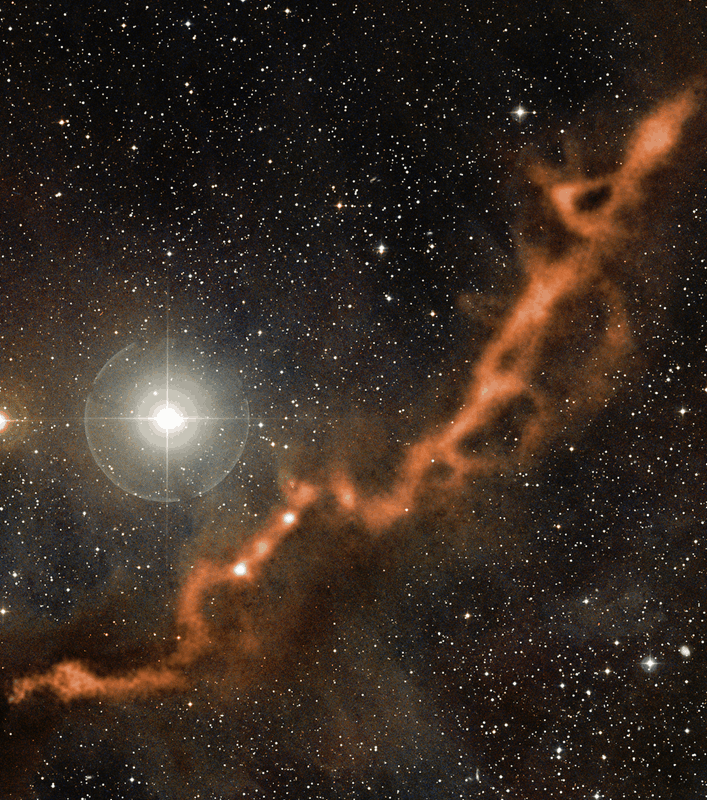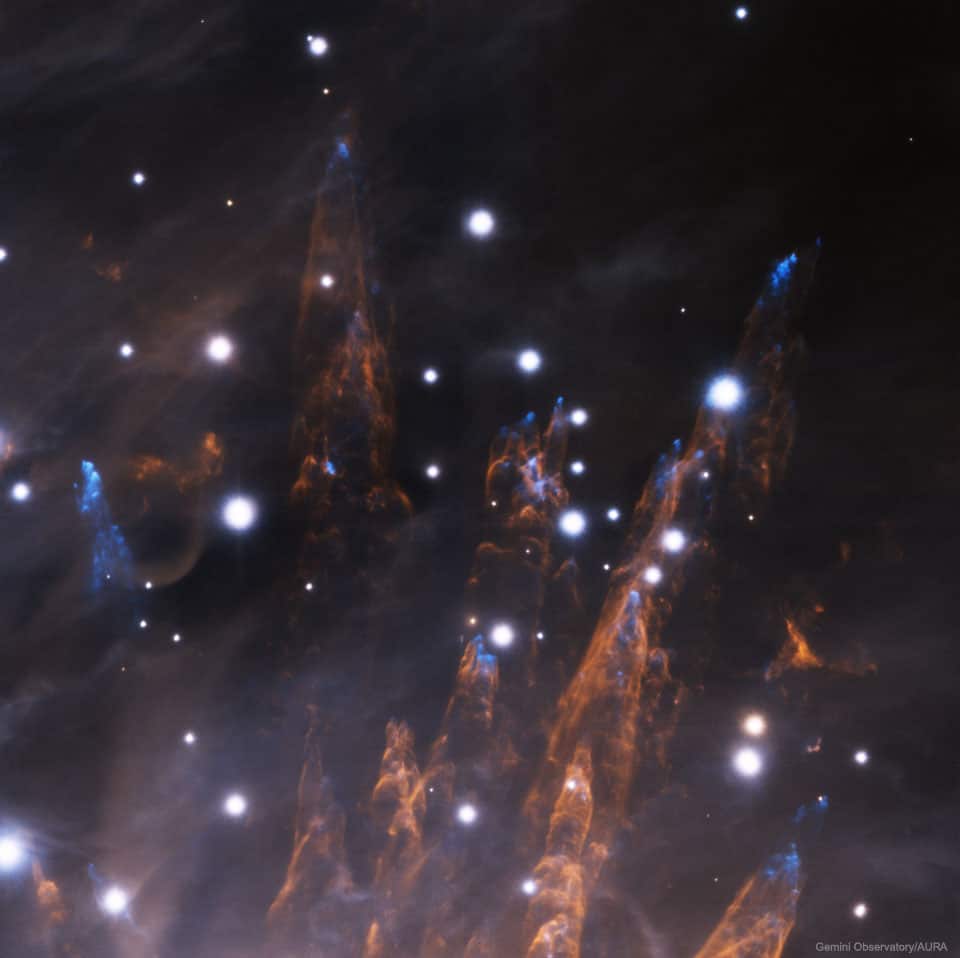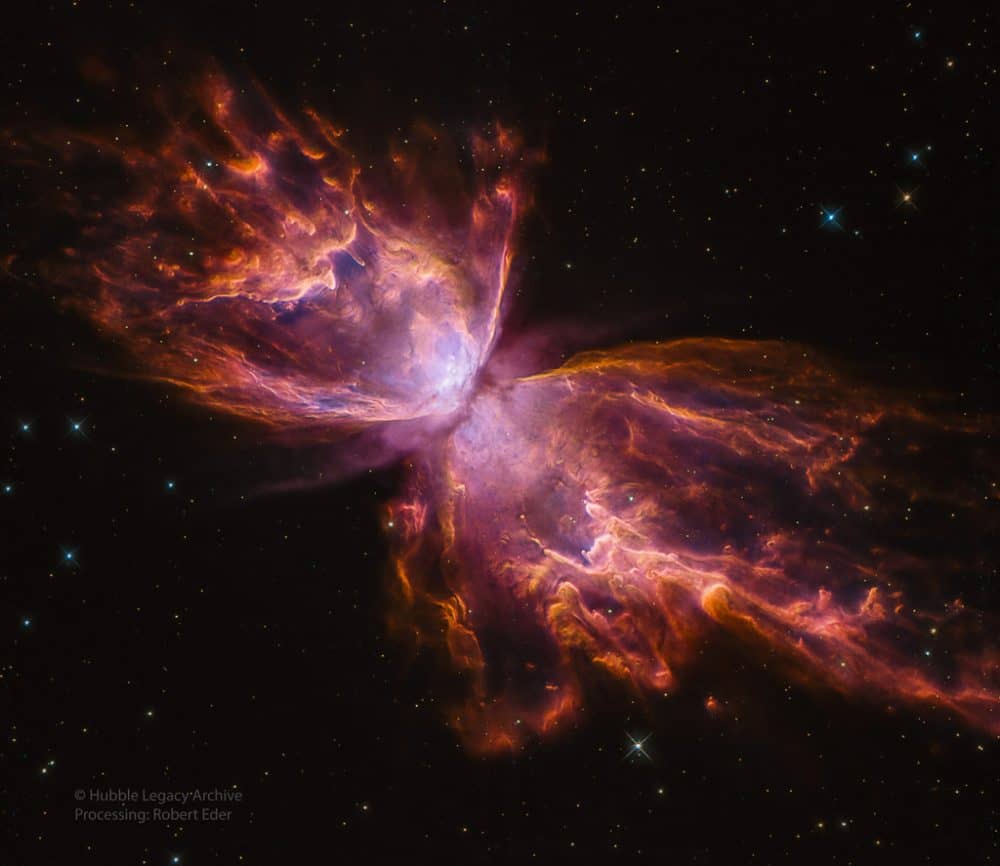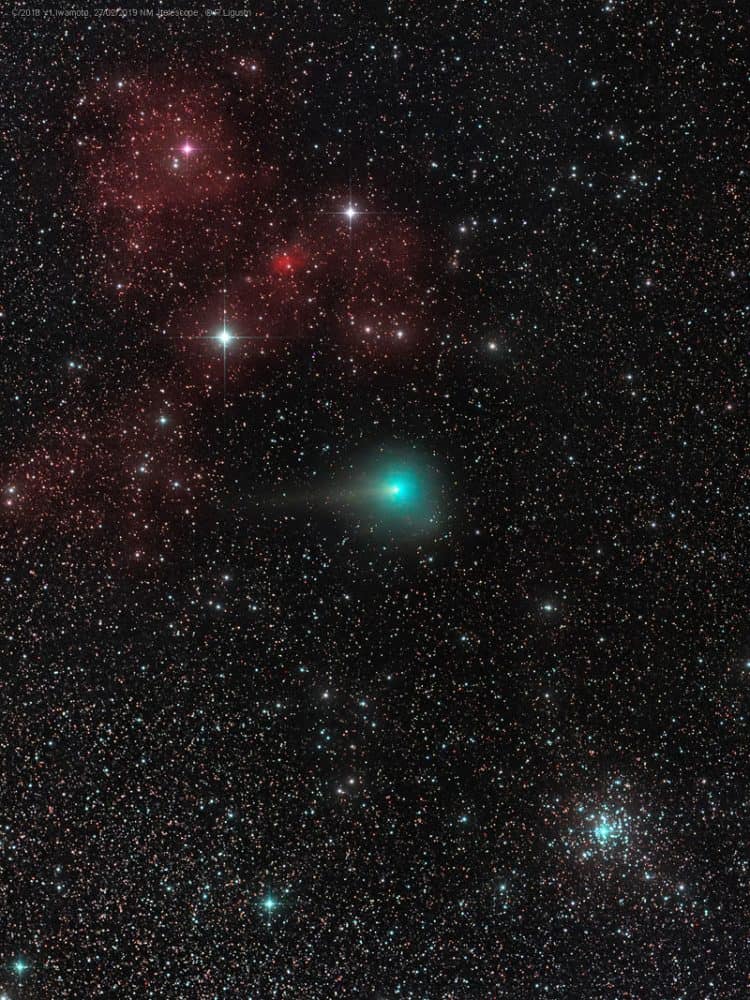Blog
The Taurus Molecular Cloud is a molecular cloud in the constellations Taurus and Auriga. This cloud hosts a stellar nursery containing hundreds of newly formed stars. The Taurus Molecular Cloud is only 140 pc (430 ly) away from earth, making it the nearest large star formation region. It also reveals characteristics that make it ideal for detailed physical studies. It has been important in star formation studies at all wavelengths. The cloud is notable for containing many complex molecules, including cyanopolyynes HCnN for n=3,5,7,9. The dusty band seen in this section of the Taurus Molecular Cloud partially hides several newly born stars as well as the dense gas clouds on the verge of collapsing into new suns. This segment of the cloud spans about 10 light-years.
more...Jan Garbarek (born 4 March 1947) is a Norwegian jazz saxophonist who is also active in classical music and world music.
Garbarek was born in Mysen, Norway, the only child of a former Polish prisoner of war, Czesław Garbarek, and a Norwegian farmer’s daughter. He grew up in Oslo, stateless until the age of seven, as there was no automatic grant of citizenship in Norway at the time. When he was 21, he married Vigdis. He is the father of musician and composer Anja Garbarek. Garbarek’s sound is one of the hallmarks of the ECM Records label, which has released virtually all of his recordings. His style incorporates a sharp-edged tone, long, keening, sustained notes, and generous use of silence. He began his recording career in the late 1960s, notably featuring on recordings by the American jazz composer George Russell (such as Electronic Sonata for Souls Loved by Nature). If he had initially appeared as a devotee of Albert Ayler and Peter Brötzmann, by 1973 he had turned his back on the harsh dissonances of avant-garde jazz, retaining only his tone from his previous approach. Garbarek gained wider recognition through his work with pianist Keith Jarrett‘s European Quartet which released the albums Belonging (1974), My Song (1977) and the live recordings Personal Mountains (1979), and Nude Ants (1979). He was also a featured soloist on Jarrett’s orchestral works Luminessence(1974) and Arbour Zena (1975).
Bobby Shew (born March 4, 1941 Albuquerque, New Mexico) is an American jazz trumpet and flugelhorn player.
After leaving college in 1960, Shew was drafted into the U.S. Army and played trumpet with the NORAD band in Colorado Springs and on tour. After leaving the Army, Shew joined Tommy Dorsey‘s band and then played with the Woody Herman and then the Buddy Rich big bands in the mid- to late 1960s. In 1972 Shew moved from Las Vegas to Los Angeles where he did much studio work as well as play with some of the top big bands of the era through the end of the 1970s: Akiyoshi/Tabackin, Bellson, Ferguson, and others. In addition to playing on several notable big band recordings starting in the 1960s, Shew recorded several albums as leader, starting with Telepathy in 1978.
Shew has mentored jazz musicians in New Mexico, and has led the Albuquerque Jazz Orchestra. He has taught a two-week workshop for high school students at the Skidmore Summer Jazz Institute in Saratoga Springs, New York, Shew also performs and teaches worldwide, including a two-week residency at the Graz University of Music in Austria in 2017. He has taught at leading European music schools in Austria, Germany, the Netherlands, and Switzerland, and also in Canada.
more...Zenzile Miriam Makeba (4 March 1932 – 9 November 2008), nicknamed Mama Africa, was a South African singer, songwriter, actress, United Nations goodwill ambassador, and civil-rightsactivist. Associated with musical genres including Afropop, jazz, and world music, she was an advocate against apartheid and white-minority government in South Africa.
Born in Johannesburg to Swazi and Xhosa parents, Makeba was forced to find employment as a child after the death of her father. She had a brief and allegedly abusive first marriage at the age of 17, gave birth to her only child in 1950, and survived breast cancer. Her vocal talent had been recognized when she was a child, and she began singing professionally in the 1950s, with the Cuban Brothers, the Manhattan Brothers, and an all-woman group, the Skylarks, performing a mixture of jazz, traditional African melodies, and Western popular music. In 1959, Makeba had a brief role in the anti-apartheid film Come Back, Africa, which brought her international attention, and led to her performing in Venice, London, and New York City. In London, she met the American singer Harry Belafonte, who became a mentor and colleague. She moved to New York City, where she became immediately popular, and recorded her first solo album in 1960. Her attempt to return to South Africa that year for her mother’s funeral was prevented by the country’s government.
Makeba’s career flourished in the United States, and she released several albums and songs, her most popular being “Pata Pata” (1967). Along with Belafonte she received a Grammy Award for her 1965 album An Evening with Belafonte/Makeba. She testified against the South African government at the United Nations and became involved in the civil rights movement. She married Stokely Carmichael, a leader of the Black Panther Party, in 1968. As a result, she lost support among white Americans and faced hostility from the US government, leading her and Carmichael to move to Guinea. She continued to perform, mostly in African countries, including at several independence celebrations. She began to write and perform music more explicitly critical of apartheid; the 1977 song “Soweto Blues“, written by her former husband Hugh Masekela, was about the Soweto uprising. After apartheid was dismantled in 1990, Makeba returned to South Africa. She continued recording and performing, including a 1991 album with Nina Simone and Dizzy Gillespie, and appeared in the 1992 film Sarafina!. She was named a UN goodwill ambassador in 1999, and campaigned for humanitarian causes. She died of a heart attack during a 2008 concert in Italy.
Makeba was among the first African musicians to receive worldwide recognition. She brought African music to a Western audience, and popularized the world music and Afropop genres. She also made popular several songs critical of apartheid, and became a symbol of opposition to the system, particularly after her right to return was revoked. Upon her death, former South African President Nelson Mandela said that “her music inspired a powerful sense of hope in all of us.”
more...Why are bullets of gas shooting out of the Orion Nebula? Nobody is yet sure. First discovered in 1983, each bullet is actually about the size of our Solar System, and moving at about 400 km/sec from a central source dubbed IRc2. The age of the bullets, which can be found from their speed and distance from IRc2, is very young — typically less than 1,000 years. As the bullets expand out the top of the Kleinmann-Lowsection of the Orion Nebula, a small percentage of iron gas causes the tip of each bullet to glow blue, while each bullet leaves a tubular pillar that glows by the light of heated hydrogen gas. The detailed image was created using the 8.1 meter Gemini South telescope in Chile with an adaptive optics system (GeMS). GeMS uses five laser generated guide stars to help compensate for the blurring effects of planet Earth’s atmosphere.
more...James Emory Garrison (March 3, 1934 – April 7, 1976) was an American jazz double bassist. He is best remembered for his association with John Coltrane from 1961 to 1967.
He formally joined Coltrane’s quartet in 1962, replacing Workman. The long trio blues “Chasin’ the Trane” is probably his first recorded performance with Coltrane and Elvin Jones. Garrison performed on many classic Coltrane recordings, including A Love Supreme. In concert with Coltrane, Garrison would often play unaccompanied improvised solos, sometimes as the prelude to a song before the other musicians joined in. After Coltrane’s death, Garrison worked and recorded with Hampton Hawes, Archie Shepp, Clifford Thornton and groups led by Elvin Jones.
Garrison also had a long association with Ornette Coleman, first recording with him on Ornette on Tenor and appeared on the outtake compilation Art of the Improvisers. He and drummer Elvin Jones have been credited with eliciting more forceful playing than usual from Coleman on the albums New York is Now and Love Call.
In 1971 and 1972, Garrison taught as a Visiting Artist at Wesleyan University and Bennington College.
more...John Smith Hurt (possibly March 3, 1892 – November 2, 1966), better known as Mississippi John Hurt, was an American country blues singer and guitarist.
Raised in Avalon, Mississippi, Hurt taught himself to play the guitar around the age of nine. He worked as a sharecropper and began playing at dances and parties, singing to a melodious fingerpicked accompaniment. His first recordings, made for Okeh Records in 1928, were commercial failures, and he continued to work as a farmer.
Dick Spottswood and Tom Hoskins, a blues enthusiast, located Hurt in 1963 and persuaded him to move to Washington, D.C. He was recorded by the Library of Congress in 1964. This helped further the American folk music revival, which led to the rediscovery of many other bluesmen of Hurt’s era. Hurt performed on the university and coffeehouse concert circuit with other Delta blues musicians who were brought out of retirement. He also recorded several albums for Vanguard Records.
Hurt returned to Mississippi, where he died, in Grenada, a year later.
Material recorded by him has been re-released by many record labels. His songs have been recorded by Bob Dylan, Dave Van Ronk, Jerry Garcia, Beck, Doc Watson, John McCutcheon, Taj Mahal, Bruce Cockburn, David Johansen, Bill Morrissey, Gillian Welch, Josh Ritter, Chris Smither, Guthrie Thomas, Parsonsfield, and Rory Block.
Hurt was born in Teoc, Carroll County, Mississippi, and raised in Avalon, Mississippi. He taught himself to play guitar at the age of nine, stealthily playing the guitar of a friend of his mother’s, who often stayed at the Hurt home while courting a woman who lived nearby. As a youth he played old-time music for friends and at dances. He worked as a farmhand and sharecropper into the 1920s.
more...Ivory Coast
more...The bright clusters and nebulae of planet Earth’s night sky are often named for flowers or insects. Though its wingspan covers over 3 light-years, NGC 6302 is no exception. With an estimated surface temperature of about 250,000 degrees C, the dying central star of this particular planetary nebula has become exceptionally hot, shining brightly in ultraviolet light but hidden from direct view by a dense torus of dust. This sharp close-up was recorded by the Hubble Space Telescope in 2009. The Hubble image data is reprocessed here, showing off the remarkable details of the complex planetary nebula. Cutting across a bright cavity of ionized gas, the dust torus surrounding the central star is near the center of this view, almost edge-on to the line-of-sight. Molecular hydrogen has been detected in the hot star’s dusty cosmic shroud. NGC 6302 lies about 4,000 light-years away in the arachnologically correct constellation of the Scorpion (Scorpius).
more...Larry Eugene Carlton (born March 2, 1948) is an American guitarist who built his career as a studio musician in the 1970s and ’80s for acts such as Steely Dan and Joni Mitchell. He has participated in thousands of recording sessions, recorded on hundreds of albums in many genres, for television and movies, and on more than 100 gold records. He has been a member of the jazz fusion groups The Crusaders and Fourplay and has maintained a long solo career.
Carlton was born in Torrance, California in 1948 and at the age of six began guitar lessons. His interest in jazz came from hearing guitarist Joe Pass on the radio. From Pass he moved on to jazz guitarists Barney Kessel and Wes Montgomery and blues guitarist B.B. King. He went to junior college and Long Beach State College while playing professionally at clubs in Los Angeles.
more...
Lewis Allan Reed (March 2, 1942 – October 27, 2013) was an American musician, singer and songwriter. He was the lead guitarist, singer and principal songwriter for the rock band the Velvet Underground and also had a solo career that spanned five decades. The Velvet Underground were not a commercial success during their existence, but are now regarded as one of the most influential bands in the history of underground and alternative rock music.
After leaving the band in 1970, Reed released twenty solo studio albums. His second, Transformer (1972), was produced by David Bowie and arranged by Mick Ronson, and brought mainstream recognition. After Transformer, the less commercial Berlin reached No. 7 on the UK Albums Chart. Rock n Roll Animal (a live album released in 1974) sold strongly, and Sally Can’t Dance (1974) peaked at No. 10 on the Billboard 200; but for a long period after, Reed’s work did not translate into sales, leading him deeper into drug addiction and alcoholism. Reed cleaned up in the early 1980s, and gradually returned to prominence with New Sensations (1984), reaching a critical and commercial career peak with his 1989 album New York.
Reed participated in the reformation of the Velvet Underground in the 1990s, and made several more albums, including a collaboration album with John Cale titled Songs for Drella which was a tribute to their former mentor Andy Warhol. 1992’s Magic and Loss, would become Reed’s highest-charting album on the UK Albums Chart, peaking at No. 6.
He contributed music to two theatrical interpretations of 19th century writers, one of which he developed into an album titled The Raven. He married his third wife Laurie Anderson in 2008, and recorded the collaboration album Lulu with Metallica. He died in 2013 of liver disease. Reed’s distinctive deadpan voice, poetic lyrics and experimental guitar playing were trademarks throughout his long career.
more...Edward F. Davis (March 2, 1922 – November 3, 1986), known professionally as Eddie “Lockjaw” Davis, was an American jazz tenor saxophonist.
Davis played with Cootie Williams, Lucky Millinder, Andy Kirk, Eddie Bonnemere, Louis Armstrong, and Count Basie, as well as leading his own bands and making many recordings as a leader. He played in the swing, bop, hard bop, Latin jazz, and soul jazz genres. Some of his recordings from the 1940s also could be classified as rhythm and blues.
His 1946 band, Eddie Davis and His Beboppers, featured Fats Navarro, Al Haig, Huey Long, Gene Ramey and Denzil Best.
In the 1950s, he was playing with Sonny Stitt, while from 1960 to 1962, he and fellow tenor saxophonist Johnny Griffin led a quintet. From the mid-1960s, Davis and Griffin also performed together as part of The Kenny Clarke-Francy Boland Big Band, along with other, mainly European, jazz musicians.
https://www.youtube.com/watch?v=Jn1Iy478ems
more...Still racing across planet Earth’s night skies, Comet Iwamoto (C/2018 Y1) shares this pretty telescopic field of view with stars and nebulae of northern constellation Auriga, the Charioteer. Captured onFebruary 27, Iwamoto’s greenish coma and faint tail appear between a complex of reddish emission nebulae and open star cluster M36 (bottom right). The reddish emission is light from hydrogen gas ionized by ultraviolet radiation from hot stars near the region’s giant molecular cloud some 6,000 light-years distant. The greenish glow from the comet, less than 5 light-minutes away, is predominantly emission from diatomic carbon molecules fluorescing in sunlight. M36, one of Auriga’s more familiar star clusters, is also a background object far beyond the Solar System, about 4,000 light-years away. Comet Iwamoto passed closest to Earth on February 12 and is outward bound in a highly elliptical orbit that will carry it beyond the Kuiper belt. With an estimated orbital period of 1,317 years it should return to the inner Solar System in 3390 AD.
more...Ralph Towner (born March 1, 1940, Chehalis, Washington) is an American multi-instrumentalist, composer, arranger and bandleader. He plays the twelve-string guitar, classical guitar, piano, synthesizer, percussion and trumpet.
Born in 1940 in Chehalis, Washington, Towner has made notable recordings of jazz, third stream under strong influence of folk and world music. He began his career as a conservatory-trained classical pianist, who picked up guitar in his senior year in college, then joined world music pioneer Paul Winter‘s “Consort” ensemble in the late 1960s. Along with bandmates Paul McCandless, Glen Moore, and Collin Walcott, Towner left the Winter Consort in 1970 to form the group Oregon, which over the course of the 1970s issued a number of highly influential records mixing folk music, Indian classical forms, and avant-garde jazz-influenced free improvisation. At the same time, Towner began a longstanding relationship with the influential ECMrecord label, which has released virtually all of his non-Oregon recordings since his 1972 debut as a leader Trios / Solos. Towner has also made numerous appearances as a sideman, perhaps most famously on jazz fusion heavyweights Weather Report‘s 1972 album I Sing the Body Electric.
Towner eschews amplification, using only 6-string nylon-string and 12-string steel-string guitars. As a result, he tends to avoid high-volume musical environments, preferring small groups of mostly acoustic instruments that emphasize dynamics and group interplay. Towner also obtains a percussive effect (e.g., “Donkey Jamboree” from Slide Show with Gary Burton) from the guitar by weaving a matchbook among the strings at the neck of the instrument. Both with Oregon and as a solo artist, Towner has made significant use of overdubbing, allowing him to play piano (or synthesizer) and guitar on the same track; his most notable use of the technique came on his 1974 album Diary, in which he plays guitar-piano duets with himself on most of the album’s 8 tracks. In the 1980s, Towner began using the Sequential Circuits Prophet-5 synthesizer fairly extensively, but has since deemphasized his synthesizer and piano playing in favor of guitar.
more...Benny Powell (March 1, 1930 – June 26, 2010) was an African-American jazz trombonist. He played both standard (tenor) trombone and bass trombone.
After leaving Basie, he freelanced in New York City. From 1966 to 1970 he was a member of the Thad Jones–Mel Lewis Jazz Orchestra, playing on Monday nights at the Village Vanguard. Among other engagements, he played in the house band of the Merv Griffin Show, and when the show moved to Los Angeles, California, in 1970 Powell also relocated there. He did extensive work as a session musician, including with Abdullah Ibrahim, John Carter, and Randy Weston. Later in his career Powell worked as an educator, including as part of the Jazzmobile project. Having moved back to New York in the 1980s, he began teaching at the New School for Jazz and Contemporary Music in 1994.
He died in a Manhattan hospital at the age of 80, following back surgery.
more...More Posts
- Comos NGC 5982/81/85
- Leon “Ndugu” Chancler
- Sameer Gupta
- Rashied Ali
- James Cotton
- Willie Dixon
- SAVE UKRAINE World Music Julian Kytasty
- Daily Roots Ashanti Roy
- Rhythm Roots Workshop Residencies Ebenezer Assisted and Independent Care
- Cosmos NGC 7129
- Lena Horne
- Stanley Clarke
- Andrew Hill
- World Drumming Babatunde Olatunji
- Flamenco Fridays Camerón
- Daily Roots Yami Bolo
- Cosmos M24
- Alexandre Lagoya
- Little Eva
- Julian Priester



